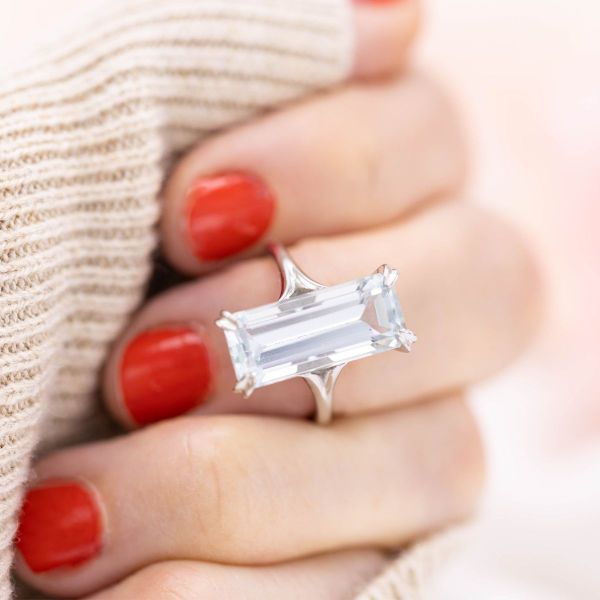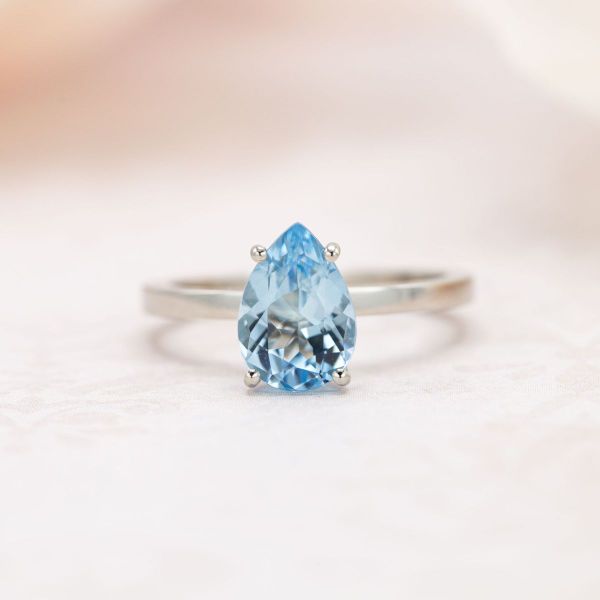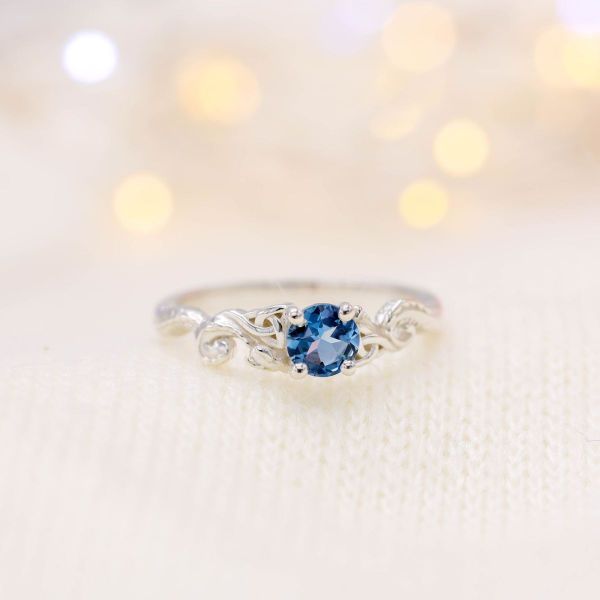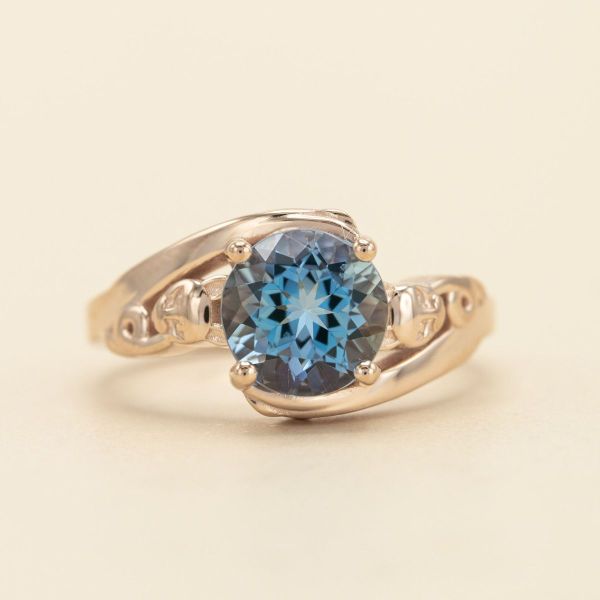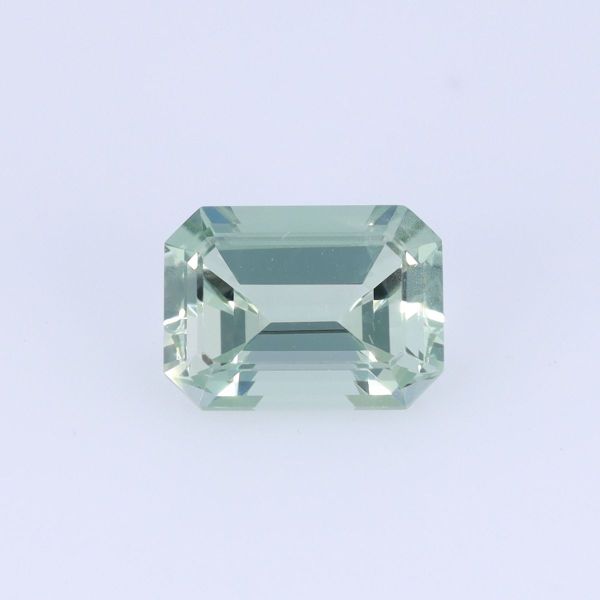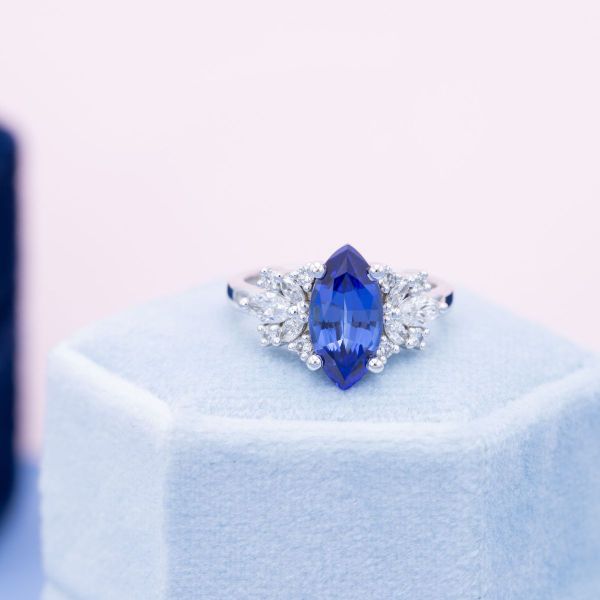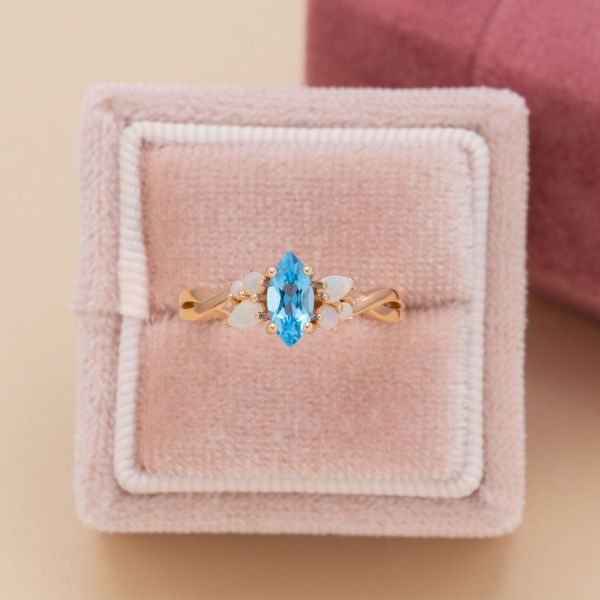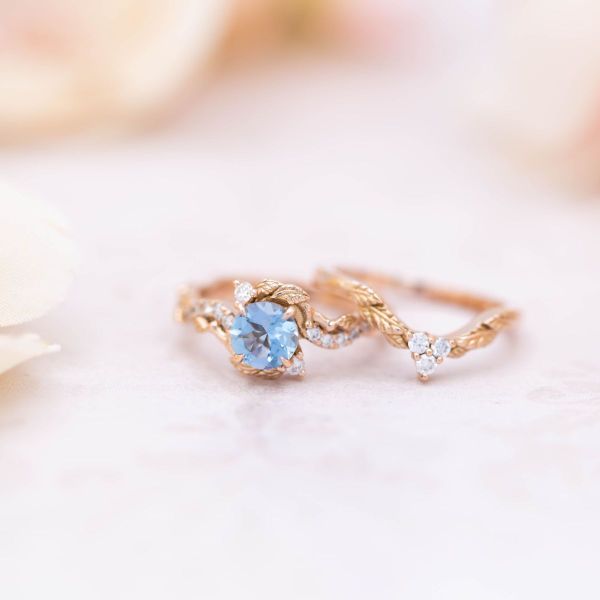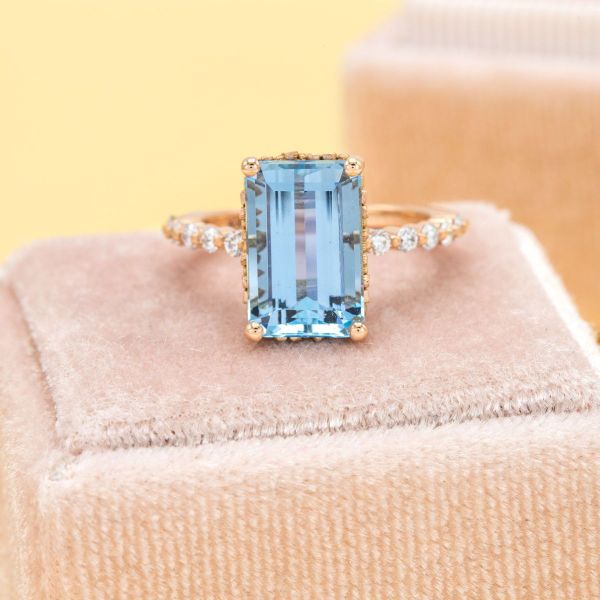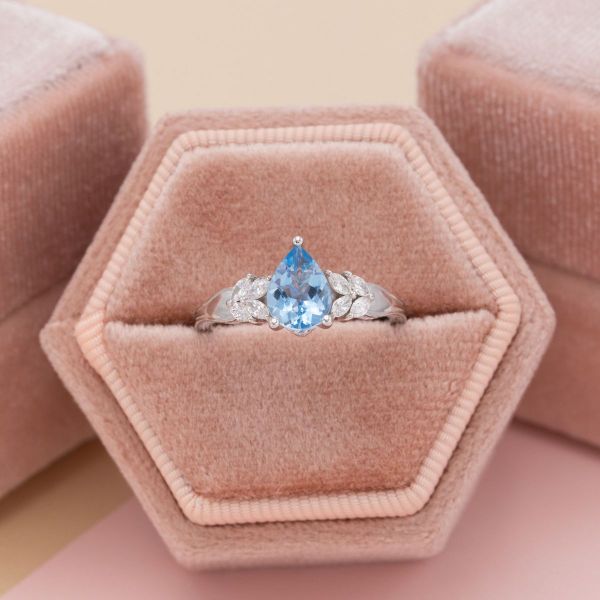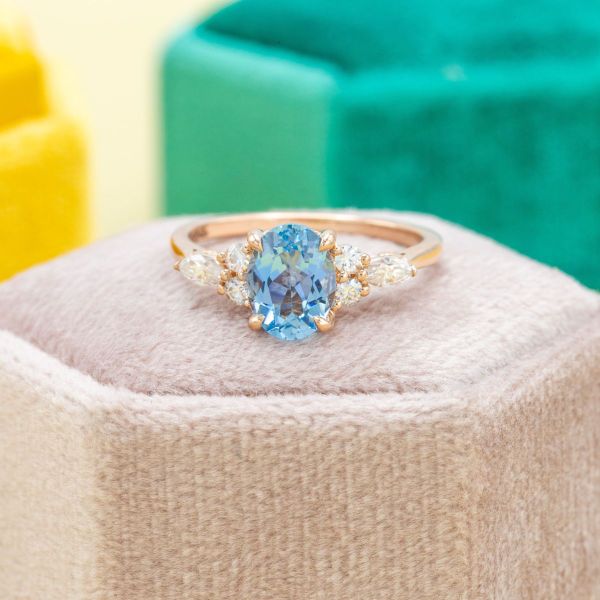Gemstone Knowledge
Exploring aquamarine's color
A deep dive into the color variances of aquamarine
Pale sky blue
While some gemstones like sapphire can have a wide range of colors, aquamarine is one of those stones that is well known for its signature color: pale, sky blue. But that doesn’t mean there’s no color variation for aquamarine, and there’s a lot to understand about the color of this sea-inspired stone.
The properties of color: hue, tone, and saturation
When diving into talking about color for gemstones, there are a few different terms thrown around and it can get a bit dizzying. The three words you’ll hear the most are hue, tone, and saturation, and they are all related to color. See? Feeling a bit dizzy? It’s not just as easy as saying “I want a green stone,” when green could look 300 different ways depending on hue, tone, and saturation.
We’ll help you out, don’t worry! While we’ll look into some of the nuances of hue, tone, and saturation here, but for a more in depth understanding of the elements of colored gemstones take a look at our gem color article.
When we’re talking about specific colors, what we’re usually actually referring to is the hue. Hue simply means where on the color wheel the gemstone falls: is it plain yellow, greenish-yellow, orangy-yellow? All of those types of typical color descriptions fall into hue, and this specific term is important to understand so you know what sort of gemstone you’re looking for based on what color, or hue, you have in mind.
While aquamarine is named after the color of sea water, you shouldn’t expect to find this gemstone in the dark bluish-green of the Atlantic Ocean we see here on the coast of Massachusetts. Instead, aquamarine comes in those crystal blue hues you see in tropical sea water, anywhere you’d go for a beachside all-inclusive vacation to sip margaritas in the sun or snorkel with the turtles.
Speaking of beaches, did you know that some rarer aquamarines do come in a greenish-blue, seafoam tint? We’ll dive a bit more into why this happens later on, but if you’re thinking a more greenish aquamarine might be for you, our gem experts can help you find that unique aquamarine of your dreams!
Moving on, where hue is looking at where on the color wheel a gemstone sits, tone is all about the lightness and darkness of the color. Instead of a color wheel that you use for hue, think of tone as a scale from white to black. If a stone has a lighter tone it will reflect almost all light so you can see all of the facets and areas of shadows inside the gem. On the other hand, a lighter toned stone will look much more closed off where you won’t be able to see all the differences within the stone and instead seems much more opaque.
One of the easiest ways to figure out if a color has a light or dark tone is simply thinking about how you would describe the color. For the sky blue of an aquamarine, you’d probably call it light blue versus the deeper navy of a sapphire you’d call dark blue. If you’d use the description of “light” or “dark” in front of color, that already gives you a good idea of where it falls on the tonal spectrum.
With aquamarine already being a light colored stone (light blue, remember?) it’s naturally going to also have a lighter tone. On a tonal scale where one is white and 10 is black, aquamarines usually fall within the one to three range. This means you don’t have to worry too much about a tone that’s too dark, so aquamarine should always look open and lively.
When we’re talking about hue, tone, and saturation for aquamarine, saturation is the most important characteristic to understand. Saturation is the intensity of the color, or the difference between the stone having just a touch of color or a more concentrated blue.
Think of saturation this way.
If you have a cup of water and add one drop of out-of-the-box blue food coloring, the water will turn a very light, subtle shade of blue. This is a light saturation. But if you take that same exact blue coloring and add four drops to the water instead, it will now appear much deeper, saturated, and concentrated. This is a strong saturation. The actual hue of the blue is exactly the same, but the concentration and depth of color changes based on just how much of that color is in the water.
Now, back to aquamarines.
Aquamarine is known for its light sky blue, but just how light is up to you based on the saturation you choose. Saturation ranges from light for a barely-there blue to strong with a highly concentrated color. Medium and medium/strong fall in the middle, covering concentrations of that beautiful sky blue anywhere between light and strong, or two and three drops of food coloring in the water instead of the one or four.
Medium/strong saturation is more popular and more expensive when it comes to aquamarine. But there’s no right answer here! We also love a very lightly saturated aquamarine for that subtle touch of color.
Still have questions about hue, tone, and saturation for aquamarine or other stones? Check out our gem color article to get the whole inside scoop.
Aquamarine color variances
Santa Maria stones are an electrified version
Let’s take a step back when it comes to aquamarine color. When we said that you should only look to aquamarine for a sky blue and not for something deeper and darker, we lied. Well, sort of.
A very specific, true blue colored variety of aquamarine was discovered in the Santa Maria de Itabira mine in the Brazilian state of Minas Gerais. Aquamarines produced here are a rarer, medium-dark hued and highly saturated blue known as “Santa Maria.” If you’re looking for a bright electric blue, Santa Maria aquamarines might just be the fit for you. However, the Santa Maria de Itabira mine is nearly exhausted and running low on these bright stones, plus the unique color of these highly prized gems will have your typically affordable aquamarine going up in price.
The rarity of this electric blue has led to a search for similarly colored aquamarines outside of the origin mine. Brightly colored aquamarine has been found in other parts of the world, and while they’re still referred to as “Santa Maria” aquamarines, keep in mind this is referring only to the color and not the location the stone is coming from.
“Santa Maria” aquamarines found in certain regions of India, Madagascar, and Mozambique are noted to have an “electric” look in light to dark tones and with greenish-blue to blue hues. These aquamarines might be referred to as “Santa Maria Africana” or “Santa Maria Afrique.” “Santa Maria” aquamarines have also been found at great heights in Pakistan and have exceptional color and clarity, famous for their dark blue color and metallic tone.
Keep in mind that a Santa Maria aquamarine will require an increase in your budget compared to a traditional aquamarine, and they also have limited availability so it will be much more difficult to find specific sizes and shapes. But if you’re in the business of a unique stone with a bright blue color and are ok with those limitations, you can’t go wrong here! And our gem experts will be happy to set off Indiana Jones-style and help you hunt one down.
Why are aquamarines heat treated?
Similar to sapphires and morganites, the majority of commercially available aquamarines are heat treated, with many of them being heated at the mine before they even reach the market. In fact, it’s almost a rarity to find a natural colored aquamarine that hasn’t been heated.
So why are these gemstones treated with heat instead of left in their natural state? The answer is to achieve that pale blue color the stone has become known for.
When mined, almost all aquamarines come out of the ground a bluish-green, more of a seafoam color than their recognizable pale blue. Why use heat to change the hue of the stone? Simply because that’s the color buyers have traditionally preferred. That’s not to say things can’t change, and untreated aquamarines are beginning to grow in popularity. It's not that it's impossible to find an unheated stone, it'll just mean a broader search and higher effort to find it.
Blue stone alternatives
Because of its reasonable price, great wearability, and unique color, it’s rare that customers set on aquamarine look for alternatives. The main reason to consider an alternative is for a darker tone or different hue of blue. While many folks love the sky blue of an aquamarine, others might be looking for something a bit more vibrant, or perhaps a slightly different hue of blue than the recognizable sky color.
Blue sapphire offers the most vivid color in a variety of blues, and the deep cobalt color is the vibrant classic. Rating a 9 on the Mohs scale of hardness, blue sapphires find themselves with a higher scratch resistance than aquamarine, but that additional hardness and deeper color comes with a higher price tag. You’re going to be looking at almost doubling your cost per carat for a mined blue sapphire compared to aquamarine, and the more vivid and deeper blue a sapphire is, the more expensive it will be. The good news with this is if you’re drawn to aquamarine for the sky blue color but also like the idea of the greater durability of sapphire, there are some light blue sapphires out there that are closer to aquamarine’s color. Incidentally, these would also be more budget-friendly than their ceylon counterparts. I hope you haven’t gotten sick of us mentioning our gem experts yet, but their work is integral in the custom engagement ring process so if a light blue sapphire is what you’re after, they can help you find one as well.
Another alternative to aquamarine for those looking for a brighter blue, irradiated blue topaz is inexpensive, beautiful, and durable. While this most well-known type of topaz does occur naturally, almost all blue topaz on the market has gone through a two-step heat and radiation treatment to take their color from pale blue to more vivid shades. Don’t be scared by the word radiation! The treatment is stable, permanent, and meant to replicate the natural exposure topaz goes through underground. The only difference is this treatment happens much quicker than the natural version’s timeline of, say, a few millions of years. It’s safe to assume all blue topazes for sale are irradiated, and they’re all stable and safe. Blue topaz is just as wearable as aquamarine when it comes to jewelry, and comes in at a slightly lower cost for those looking to achieve a brighter blue.
Another blue stone option for those looking for something a bit more prestigious in the light blue family is a color-treated blue diamond. This option is the hardest of the blue stones since it is a diamond and offers the most sparkle as well. But that prestige will cost you, with a one carat mined, color-enhanced option costing at least five times as much as an aquamarine, and that’s betting on the low end and will likely cost you much more. Considering a one carat mined, natural blue diamond in place of a one carat aquamarine? Plan to shell out between $20,000 and $500,000. Blue diamonds are certainly an option for those looking for that high-end flair, but those not interested in such an expense will be just as happy with an aquamarine.
Conclusion
So after diving into the nuances of aquamarine and other blue stone alternatives, is aquamarine the choice for you? If you’re looking for a pale, sky blue for your center stone, aquamarine is a great fit! While there are many options for stones covering the blue spectrum, nothing has quite the same crystal water blue as an aquamarine.
About CustomMade
CustomMade designs and creates one-of-a-kind, custom engagement rings and fine jewelry. Each piece we create is inspired by you, designed for you, and made just for you.


